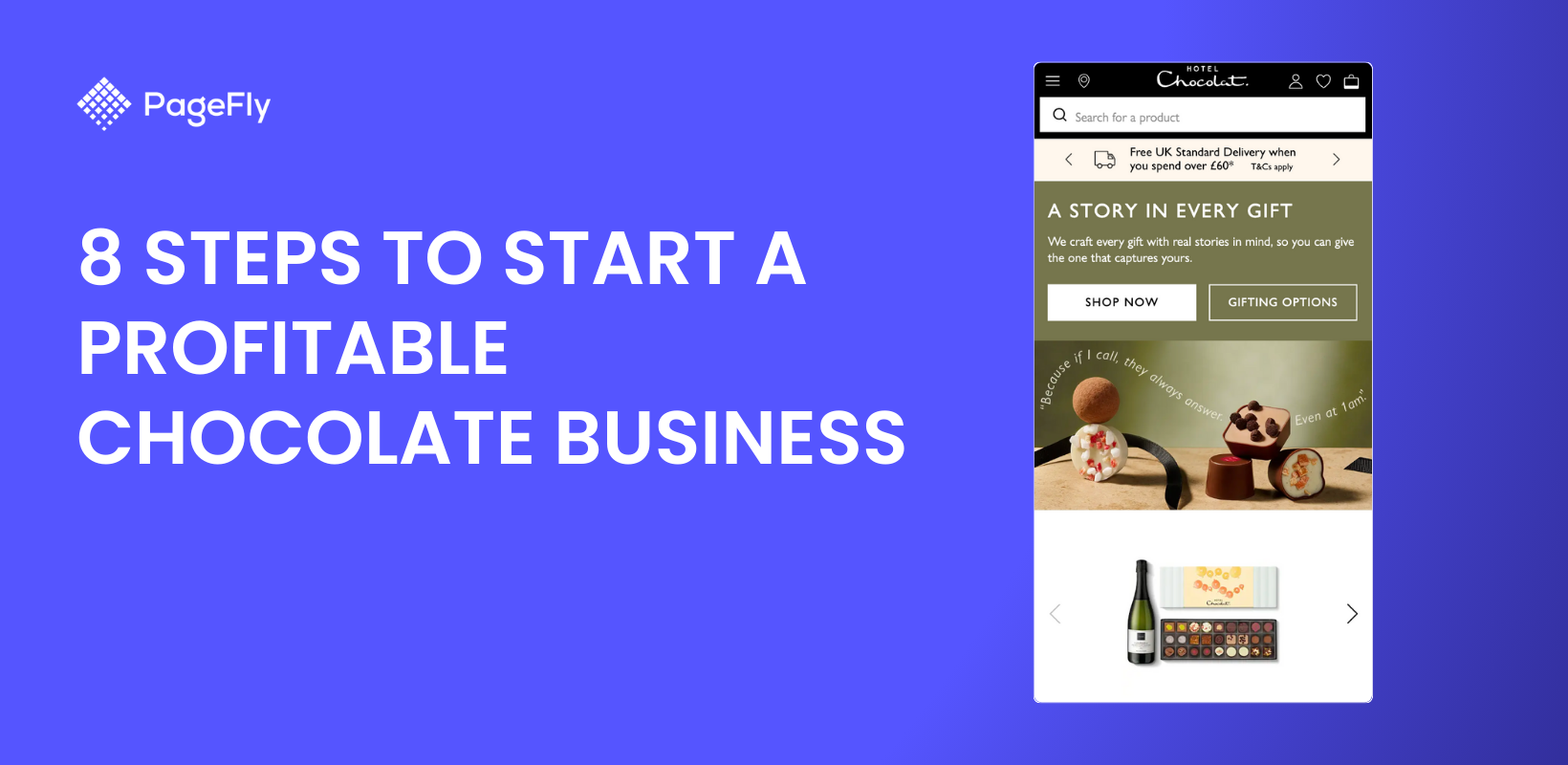Starting a chocolate business from home is an achievable dream that combines passion with profit potential in the growing artisan food market. Whether you envision launching an artisan chocolate business focused on handcrafted truffles or developing a chocolate subscription business serving monthly curated selections, the chocolate industry offers multiple pathways to entrepreneurial success.
The chocolate business landscape provides excellent opportunities for home-based entrepreneurs, with startup costs as low as $3,000 and profit margins reaching 50-70% for specialty chocolates. From bean-to-bar chocolate making to custom corporate gifts, successful chocolate businesses serve diverse market segments including health-conscious consumers, luxury gift buyers, and businesses seeking unique employee perks.
This comprehensive guide walks you through 8 essential steps to launch your chocolate business, covering everything from regulatory requirements and equipment selection to marketing strategies and financial planning. You'll learn how to choose between different business models, understand licensing requirements, and develop products that stand out in today's competitive marketplace.
Examples include chocolate-covered raisins, chocolate-covered nuts, chocolate caramels, chocolate fountains, and chocolate toffees. If chocolate makers enjoy chocolate and have some culinary skills, you could start your own chocolate business and earn well while cheering up lots of people. If your candies are exceptional, you may be able to capture a portion of that sizable market since fine, handmade chocolates command a premium.
However, you must develop your chocolate business acumen before you begin cooking. Fortunately, you can learn all the entrepreneurial knowledge you need to launch a prosperous chocolate business by reading this step-by-step manual.
Is This Chocolate Business Right For you?
Pros and cons
Before deciding whether starting a chocolate business is right for you, weigh the benefits and drawbacks.
Pros
- Share Your Passion – Share your skills and love of chocolate with others
- Good Money – Profit margins on chocolates are high
- Flexibility – Run your business from home, set your own hours
Cons
- Time Consuming – Making and packaging chocolates takes time
- Saturated Market – The chocolate industry is highly competitive
Chocolate industry trends
Industry size and growth
- Industry size and past growth – In 2021, the US chocolate business was worth $19 billion, down slightly from the previous five years.
- Growth forecast – Over the following five years, there will likely be a slight increase in the US chocolate market.
- Number of businesses – A total of 3482 chocolate brands were active in the US in 2021.
- Number of people employed – 43,017 people were employed by the US chocolate manufacturing industry in 2021.

Source: Step by Step Business
Trends and challenges
Trends in the chocolate business include:
- In addition to chocolates with fruits and nuts, plant-based and vegan options are becoming more popular.
- In an effort to increase the nutritional value of their chocolates, many chocolate manufacturers such as Alter Eco Foods, Hu Kitchen, and Lake Champlain Chocolates are developing recipes that include vitamins and antioxidants.
Challenges in the chocolate business include:
- The profit margins of chocolate manufacturing companies are being impacted by rising prices for cocoa, cocoa butter, sugar, almonds, and vanilla.
- Deforestation caused by cocoa farming may result in new regulations that result in a shortage of the commodity.

How much does it cost to start a chocolate business?
Starting a chocolate business can cost between $3,000 and $8,000. The price includes packaging materials, ingredients, and machinery for making chocolate.
You can enroll in classes for making chocolate.
To successfully launch your chocolate business, you'll need a few things, such as:
- Candy thermometers
- Pots and pans
- Stove
- Baking sheets
- Mixers
- Mixing bowls
- Refrigerator
- Packaging supplies
What barriers to entry are there?
There are some obstacles to starting a chocolate business. Your main obstacles will be:
- The capacity to create delicious chocolate
- Entering a market where there are established players like Anthony Thomas and the Rocky Mountain Chocolate Company
Related Business Ideas
Choosing Your Chocolate Business Model
Before diving into startup costs and equipment, it's crucial to define your specific chocolate business model. Each approach has different startup requirements, profit margins, and target markets.
Artisan Chocolate Business Models
Bean-to-Bar Chocolate Making: This premium model involves sourcing cacao beans directly from farms and controlling the entire chocolate-making process. Startup costs range from $15,000-$50,000 for equipment, but profit margins can reach 70-80% for premium bars selling at $8-15 each. This model appeals to conscious consumers seeking transparency and unique flavor profiles.
Artisan Chocolatier Confections: Focus on handcrafted truffles, bonbons, and filled chocolates using high-quality couverture chocolate. Lower startup costs ($3,000-$8,000) but requires significant time investment. Successful artisan chocolatiers often charge $30-60 per pound for handmade confections.
Custom Chocolate Creations: Specialize in personalized chocolates for weddings, corporate events, and special occasions. This B2B model offers higher margins ($50-100+ per order) but requires strong marketing and customer service skills. Popular offerings include custom molds, branded packaging, and seasonal designs.
Chocolate Subscription Business Opportunities
Curated Chocolate Discovery Boxes: Monthly subscription boxes featuring chocolates from different regions or makers. Successful models like Chococo and ChocoVine generate $30-50 monthly recurring revenue per subscriber. Requires strong supplier relationships and marketing investment but offers predictable recurring income.
Personalized Health-Focused Subscriptions: Target health-conscious consumers with sugar-free, vegan, or keto-friendly chocolate options. Premium pricing ($40-80 per monthly box) serves niche markets willing to pay for dietary-specific products.
Corporate Wellness Programs: B2B subscription model providing healthy chocolate snacks to offices. Companies increasingly invest in employee wellness, making this a growing market segment with contracts worth $500-5,000+ monthly.
Hybrid Business Model Strategies
Retail + Online Combination: Many successful chocolate businesses combine physical retail presence with e-commerce and subscription offerings. This diversified approach reduces risk and maximizes revenue opportunities across different customer segments.
Education + Products: Offer chocolate-making classes, workshops, and team-building events alongside product sales. This high-margin service component (classes typically charge $50-150 per person) builds brand loyalty while generating additional revenue streams.
Seasonal Specialization: Focus on high-demand periods (Valentine's Day, Easter, Christmas) while maintaining smaller operations during slower months. This model can generate 60-80% of annual revenue during peak seasons.
Here are some related business opportunities to aid you on your road to entrepreneurship success if you're still not sure if this business concept is the best fit for you.
8 Steps to Start a Chocolate Business
1. Create a Business Plan
Every company requires a strategy. This will serve as a manual to help your startup get through the launch process while staying focused on your main objectives. Additionally, a business plan helps potential investors and partners comprehend your company and its mission:
- Executive Summary: A succinct summary of the entire business plan, which ought to be written after the plan is finished.
- Business Overview: Overview of the business, including ownership, vision, and mission.
- Product and Services: Give a thorough description of your services.
- Market Analysis: SWOT analysis should be used to evaluate market trends, such as variations in demand and growth prospects.
- Competitive Analysis: Make a list of the benefits of your services after analyzing the strengths and weaknesses of your main competitors.
- Sales and Marketing: Examine the unique selling propositions (USPs) of your businesses and create sales, marketing, and promotional plans.
- Management Team: Overview of the management team, including a corporate hierarchy, information on their responsibilities and backgrounds.
- Operations Plan: The operational plan for your business specifies logistics, office location, key assets, and equipment.
- Financial Plan: Financial planning for three years, including startup costs, break-even analysis, profit and loss projections, cash flow, and a balance sheet.
- Appendix: Add any additional financial or commercial documentation.
It can be intimidating to write a business plan if you've never done it before. You might think about paying a Fiverr business plan expert to write a top-notch business plan for you.
💡 Quick Read - Top 10 Business Ideas in The USA for 2023
2. Brainstorm chocolate business name ideas
Finding chocolate business name ideas that accurately expresses your goals, offerings, and mission. Your chocolate business name serves as your company's identity. Given that a large portion of your business, and especially your initial business, will come from recommendations made by friends and family, you probably want a name that is brief and simple to remember.
Here are some ideas for brainstorming your chocolate business name ideas:
- Short, unique, and catchy names tend to stand out
- Chocolate business names that are easy to say and spell tend to do better
- Chocolate business names should be relevant to your product or service offerings
- Ask around — family, friends, colleagues, social media — for suggestions
- Including keywords, such as “chocolates” or “chocolate candies”, boosts SEO
- Name should allow for expansion, for ex: “Jim’s Bakery” over “Jim’s Cookies”
- Avoid location-based names that might hinder future expansion
- Use online tools like the Chocolate Business Name Generator. Just type in a few keywords and hit “generate shop name” and you’ll have dozens of unique chocolate business names at your fingertips.

3. Structure the Enterprise
Form a legal entity
There are numerous types of business entities, each with advantages and disadvantages. Make a wise decision when selecting the legal structure for your chocolate company because it will affect your taxes, personal liability, and business registration requirements.
Here are the main options:
- Sole Proprietorship
- General Partnership
- Limited Liability Company (LLC)
- C Corp
- S Corp
We advise new business owners to choose an LLC because it is less complicated to form than a corporation and offers liability protection and pass-through taxation.
Register your Chocolate Business
Additionally, registration is exciting because it gives the procedure official status. When it's finished, you'll own your own chocolate business!
Choose where to register your company
Because it may have an impact on taxes, legal requirements, and revenue, your business location is crucial. The majority of people will register their business in the state where they currently reside, but if you're planning to grow, you may want to look elsewhere because some states may actually provide advantages for chocolate businesses.
Your chocolate business could really grow if you're willing to relocate. Remember that moving your chocolate business to another state is not too difficult.
Register for taxes
Obtaining an Employer Identification Number, or EIN, is the last step before you can start paying taxes. Visit the IRS website for more information on how to apply for your EIN online, by mail, or by fax. Remember that if you've decided to operate as a sole proprietorship, your EIN can simply be your social security number.
To make sure you're filing your taxes correctly, it's crucial to seek the advice of an accountant or other expert.
Open a business bank account & credit card
For the protection of personal assets, it is crucial to use special business banking and credit accounts.
Additionally, understanding how to establish business credit can help you get loans, credit cards, and other financing in your chocolate business's name rather than your own, as well as get better terms and credit limits.
Open a business bank account
Opening a business bank account is necessary for several reasons, including:
- Separation of your personal assets from those of your business is a requirement for personal asset protection.
- Simplifies accounting and tax filing.
Open net 30 accounts
Net 30 accounts are used to create and maintain business credit and to boost cash flow. Businesses use a net 30 account to purchase goods and pay off the entire balance within a 30-day period.
Get a business credit card
Getting a business credit card helps you:
- Arranging your company's expenses in a single location.
- Create a credit history for your business, which will be helpful if you ever need to raise capital.
Set up business accounting
Understanding your business's financial performance depends on keeping track of all of your expenses and revenue sources. Maintaining precise and thorough records also makes filing your yearly taxes much simpler.
Food Safety & Regulatory Compliance Requirements
Starting a chocolate business requires strict adherence to food safety regulations and obtaining proper certifications. These requirements vary by location and business model, so always consult local authorities for your specific situation.
Essential Food Safety Certifications
Food Handler's Permit: All chocolate business owners must obtain food safety certification. In most states, this involves completing a ServSafe course or equivalent training program. The certification covers proper food handling, storage temperatures, cross-contamination prevention, and personal hygiene standards.
HACCP Compliance: Larger operations may need Hazard Analysis Critical Control Points (HACCP) plans. This systematic approach identifies potential food safety hazards and establishes critical control points in your chocolate production process.
FDA Requirements for Chocolate Businesses
Facility Registration: If you plan to sell across state lines or to wholesalers, you must register your facility with the FDA under the Food Safety Modernization Act (FSMA). This applies even to home-based operations that sell interstate.
Nutritional Labeling: All packaged chocolate products must include proper nutritional facts panels, ingredient lists, and allergen warnings. Common allergens in chocolate include milk, nuts, soy, and wheat. The FDA requires specific formatting and font sizes for these labels.
Good Manufacturing Practices (GMP): Your production area must meet FDA standards for cleanliness, equipment sanitation, and employee hygiene. This includes proper hand-washing stations, hair restraints, and clean clothing requirements.
State and Local Licensing Requirements
Business License: Register your business entity (LLC recommended) and obtain local business permits. Check with your city clerk's office for specific requirements.
Food Facility License: Your state health department will require a food facility license and regular inspections. Inspection frequency typically ranges from quarterly to annually, depending on your state and business size.
Cottage Food Laws: Many states offer simplified regulations for home-based food businesses. These "cottage food" permits often limit where you can sell (direct sales only, farmers markets, etc.) and may cap annual revenue. States like California allow up to $75,000 in cottage food sales annually.
Specialty Considerations for Artisan Chocolate
Organic Certification: If marketing organic chocolates, obtain USDA Organic certification through an accredited certifying agency. This process typically takes 6-12 months and requires detailed documentation of your supply chain.
Fair Trade Certification: For ethically-sourced chocolate claims, consider Fair Trade USA or Rainforest Alliance certification. This adds credibility but requires ongoing fees and compliance monitoring.
Allergen Controls: Implement strict allergen management if producing both nut-containing and nut-free chocolates. This may require separate production areas or thorough cleaning protocols between batches.
Insurance and Liability Protection
Product Liability Insurance: Essential for any food business. Policies typically range from $1-5 million coverage and cost $500-2,000 annually for small chocolate businesses.
General Business Insurance: Protects against property damage, theft, and general liability claims. Many insurers offer small food business packages combining multiple coverage types.
Heavy fines and even the closure of your business may result from failing to obtain the required permits and licenses.
4. Essential Equipment for Your Chocolate Business
The equipment you need depends on whether you're starting as a chocolatier (working with pre-made chocolate) or chocolate maker (bean-to-bar production). Here's a comprehensive breakdown of equipment options and costs for different business scales.
Home-Based Chocolatier Equipment ($1,500 - $3,500)
Essential Tools for Chocolate Confections:
- Digital candy thermometer ($25-50): Critical for proper chocolate tempering
- Stand mixer (5+ quart) ($200-400): KitchenAid Professional or equivalent for ganache and fillings
- Chocolate melting machine ($150-300): Double boiler or specialized chocolate melter
- Silicone molds ($50-150): Professional-grade molds for truffles, bars, and bonbons
- Digital scale ($30-80): Essential for consistent recipes and portion control
- Dipping forks ($20-40): Professional chocolate dipping tools
- Sheet pans and cooling racks ($50-100): Food-grade stainless steel preferred
Packaging and Storage Equipment:
- Vacuum sealer ($100-200): Extends shelf life and creates professional packaging
- Heat sealer ($50-150): For custom packaging and labels
- Commercial refrigerator ($800-1,500): Dedicated storage for finished products
- Storage containers ($50-100): Food-grade containers for ingredients
Small-Scale Bean-to-Bar Setup ($8,000 - $15,000)
Specialized Chocolate Making Equipment:
- Cocoa bean roaster ($2,000-5,000): Behmor 2000AB modified or entry-level drum roaster
- Winnower ($500-1,200): Separates cocoa nibs from shells
- Stone grinder/melanger ($800-2,000): Premier Chocolate Refiner or CocoaTown models
- Conching machine ($1,500-3,500): For texture development and flavor refinement
- Tempering machine ($1,000-3,000): Automated tempering for consistent results
- Chocolate molds and bars ($200-500): Professional bar molds and depositing equipment
Equipment Sourcing Recommendations
New Equipment Suppliers:
- JKV Chocolate Machines: Professional-grade equipment with service support
- Savage Brothers: Used chocolate equipment specialists with quality guarantees
- CocoaTown: Affordable stone grinders and small-batch equipment
- Tomric Systems: Complete turnkey chocolate production systems
Cost-Saving Strategies:
- Buy used equipment: Check eBay, restaurant equipment auctions, and industry forums for 30-50% savings
- Start small and upgrade: Begin with basic tools and invest profits into better equipment
- Equipment leasing: Many suppliers offer financing options for larger purchases
- Multi-purpose tools: Choose equipment that serves multiple functions to reduce initial investment
Equipment Maintenance and Safety
Regular Maintenance Schedule:
- Clean all equipment thoroughly after each use with food-safe sanitizers
- Calibrate thermometers monthly for accuracy
- Service mechanical equipment quarterly or per manufacturer recommendations
- Keep maintenance logs for health department inspections
Safety Requirements:
- Install proper ventilation for chocolate dust and vapors
- Ensure all electrical equipment meets commercial food service standards
- Provide adequate fire suppression in production areas
- Train all employees on equipment safety procedures
Given the right tools, anyone can launch a small chocolate business from their home. At the very least, a sizable mixer as well as various molds and pans will be needed.
5. Take a Practice Run
Use your friends, family, and coworkers as test subjects to see how well your chocolates work. As you get ready for the big day, you can use that feedback to make adjustments to your recipes. Free samples distributed locally on-site at community gatherings like fairs or parades are a great way to build organic word-of-mouth recognition in your neighborhood. To ensure that your chocolates are a success right out of the gate once you decide to go live, it is crucial to conduct as much in-depth market research as you can.
6. Launch the Business
All you need to accept non-cash payments when selling your products in-person offline is an app like Square and a tablet or smartphone. The simplest way to set up a storefront to sell your products online is typically through a platform like Shopify or BigCommerce. You could also sell confections to customers who live far away using Amazon and even Etsy. Create merchant accounts with shipping companies like FedEx, UPS, and the US Postal Service to receive rate breaks. Stock up on plenty of packaging and labels.
💡 Quick Read - How Does Shopify work? | Shopify vs Your Own Website: Which One to Invest in 2024?
7. Go Digital
The key to achieving profitability as soon as possible is aggressive marketing. Create a flagship website for your company first, then use it as a landing page to advertise on social media platforms like Facebook and Twitter. Make an effort to visually emphasize your chocolates' appealing aesthetics online. Use popular YouTube videos and excellent blog content to attract new readers.
8. Keeping the Dream Alive
Small businesses find it difficult to stay afloat due to the ephemeral nature of the food industry. Diversification and adaptability will be crucial if you want to last a long time. Keep an eye out for fresh opportunities and act quickly when new consumer demand trends emerge. Try out new chocolate products while still providing a wide range of popular favorites. Your chocolate side business will make money for years to come with a little luck and some inventive marketing.
Examples of Successful Chocolate Business Stories
Manoa Chocolate
Manoa is a chocolate producer with its headquarters in Hawaii. Hawaii is the only state in the USA where cacao is grown. In 2010, cacao was being investigated as a potential state crop in the labs at the University of Hawaii. This was the beginning of the story of this maker. Manoa was founded by impoverished college students who used tenacity and creativity to bootstrap their business.

They initially had a tricycle-powered winnower to remove the cacao shells and a barbecue for roasting. Manoa is the biggest chocolate producer in Hawaii and currently among the top ten largest bean-to-bar craft chocolate producers in the US.
Their YouTube channel has contributed to the success of Manoa Chocolate in reaching chocolate lovers all over the world and promoting their craft chocolate. In order for other aspiring chocolatiers to have a successful start at their own business, they are attempting to educate people about how we make chocolate as well as the procedure and business.
You can visit their YouTube Channel here.
Midday Squares

In 2018, Nick and Lezlie Saltarelli decided to make their own practical, protein-rich chocolate bar in their condo kitchen after noticing a gap in the market for chocolate.
Mid-Day Squares, a Montreal-based company, is revolutionizing the afternoon snack market one chocolate square at a time.
In just under 20 months, Nick and Lezlie have raised $21 million and sold more than one million chocolate bars.
Nick is in charge of all investor negotiations, brand partnerships, and financial and marketing strategies.
Conclusion
A classic treat, chocolate will always be available for chocolate lovers. You can capitalize on the enormous US market with your own chocolate company. Why not earn some money from your excellent chocolate-making abilities and the chocolates that your loved ones adore? Starting at home can lead to the development of a production facility that you can use to create your own chocolate brand.
You've done your research on the business world, so it's time to start confectioning your way to a lucrative chocolate business!









![14 Profitable Small Food Business Ideas for 2025 [Real Numbers]](http://pagefly.io/cdn/shop/articles/1_58b587d2-13db-4aa6-8c19-e40f5c88d3eb.jpg?v=1758255771&width=4460)
![Art Business Names: 350+ Ideas + Free Generator [2025 Updated]](http://pagefly.io/cdn/shop/articles/art_business_name_e94a54e9-d325-4ba3-94ab-7b4297952312.png?v=1760062968&width=1640)






